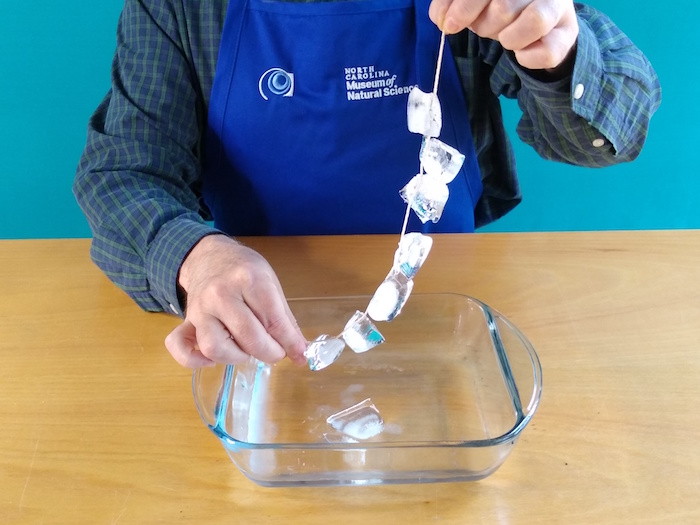Science At Home! Make an Ice Necklace
For immediate release ‐ April 23, 2020
Contact: Jessica Wackes, 919.707.9850. Images available upon request
Looking for something to do to keep your brain active and engaged? We’re here to help with Science at Home! Over the next few weeks, we’ll be providing you with fun science experiments you can conduct using commonly found items. You can also visit us at the Museum’s Science at Home page for additional resources!
Make an Ice Cube Necklace PDF (for printing)
MATERIALS NEEDED
- Ice cubes
- Table salt
- Cotton string
- Water
- Shallow dish or container
- Scissors
- Ruler

EXPERIMENT INSTRUCTIONS
Step 1: Place several ice cubes in the container.

Step 2: Fill with water just barely until the ice cubes begin to float.

Step 3: Cut a length of string about 12 inches long and soak it until it is completely wet throughout.

Step 4: Lay the wet string across as many ice cubes as you can. Note: ensure the string makes a lot of contact with each cube.

Step 5: Get a pinch of salt and carefully sprinkle salt all along the length of the string.

Step 6: Wait approximately 30 seconds. Then carefully lift one end of the string and see how many cubes remain attached. You’ve now created your very own ice cube necklace!

What We’ve Learned
As a liquid, water molecules are always moving. But as water gets colder, its molecules begin to lose energy and slow down. When this occurs, water molecules link together to form a crystalline structure, or, ice.
When salt dissolves in water it separates into ions of sodium and chlorine. These ions prevent the water molecules from linking up. Even though the water is cold enough to freeze, it remains in liquid form.
The process of salt dissolving in water creates a reaction that takes heat energy away from the surrounding area, which cools it dramatically. The film of water that is slightly further away — and less impacted by the salt — then freezes, trapping the string to the ice cube.
Having Fun?
We want to see! Tag @naturalsciences on social media, so we can see you and your loved ones enjoying our Science at Home experiments.

